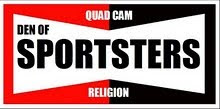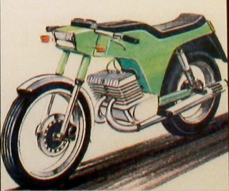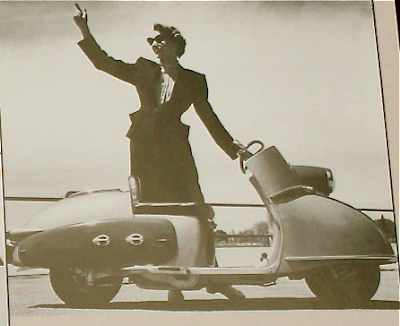Chilly winter nights are my favorite for diving into the corners of my library, where good two-wheeled prose keeps me company. It's a good time to share some of my favorite pieces of writing on the subject, by various authors in different periods. Writing styles, especially journalistic habits, have changed dramatically over the past century; at one time literary giants who wrote Good English on the subject of Motorcycling strode the earth; they're my inspiration in an age of breathless product endorsement. To be sure though, there are greats today who choose two wheels as their subject, and I'll include a few of their efforts as well over the coming weeks.
Last year I posted T.E. Lawrence's
The Road (from' The Mint', read it here), which is essential reading for any Vintagent. Today's inclusion is from 'Castor' (Dennis May's
nom de plume), of
Motor Cycling magazine, August 17th, 1932.
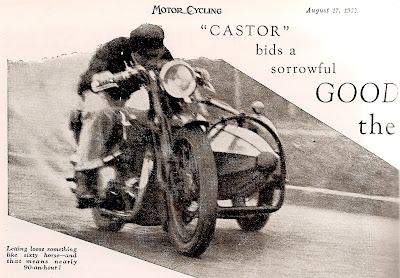
I've included some notes at the bottom for 21st Century English translation, of items I couldn't find reference to on the Web!
"Castor" bids a sorrowful GOOD BYE to the ULTRA FAST SIDECAR OUTFIT!Below and without, dolls-housey from this seventh-storey window, stands a rank of many-specied vehicles. And at the end two cheap motorcycles.
One is a miniature-engiend pop-gun of 148cc. the other is the
Brough Sup. Howitzer which you see at the head of this column emerging from a bitter-sweet murk of Castrol gas at nearly ninety-an-hour. It would cost you, as it stands, perhaps £180. and it would be cheap, because there exists, I imagine, nothing else at the price upon which you and the passenger of your choice could capture the same thrill of rapturous gusty speed.
These ultra-fast sidecar outfits are a dying race, it has seemed to me. The time was, seven, eight or more years ago, when they were a common sight along the roads: lean S.S. Hundreds of the late pre-chromium era, that sucked an exacting
benzole blend through drain-pipe jets; now and then a bulbous, bold-fronted
Flying Eight, clamped in rock-like unity to a T.T. Hughes
[1] - all strutted and stayed like a mobile
Sydney Bridge. Or perhaps it was a
Replica Norton, with padded rear and near-side wings and the single's tuny beat, that left you wondering...and wishing, perhaps.
Where are they now, these Big Guns of the sidecar world? The answer, in the language of the telephone, is No Reply.
Perhaps, I thought,
George Brough could tell me. Wrong again; he couldn't. But he would lend what his letter called a "highly tuned S.S.100," which Ron Storey
[2], the fastest man on the sand, had cared for. Which left that friendly and resourceful sidecar trader, Maurice Wolston of
Brixton Hill, to furnish a T.T. Hughes; and the human race at large to delegate a passenger.
This the human race accomplished easily, even if its representative was wont, as he said, to go to sleep in sidecars, and really I mustn't feel offended, etc., etc., etc.
Digressing, let me describe briefly the oufit as it stood at the setting out upon the most acutely wakeful ride in this passenger's career. One 8-55 long-stroke J.A.P. engine, with compression suited to a 50/50 mixture of Ethyl Special. Four-speed box, with tank-side gear-shift, the three high ratios close and the fourth nowhere. Eight-inch brakes fore, aft, and port. Three and a half gallon tank of Ethyl A, full measure, pressed down and almost running over.
Twin carbjectors
[2]; throaty, vacant-sounding chaps, pleasant to hear. fixed at four firm points, one genuine Hughes basket, wherein basked one genuine human, to gallons spare Ethyl A, one quart spare
Castrol "R", on gross British
"Beech Nut" (permanent flavor - no,
flavour).

Let's go!
Well, where? Fifty laps of
Brooklands "road" course. Why not? For there, at least, there is nothing in the way.
Already I have tried to refuse the theory that these big huskies are the playthings only of the Very Rich. Developing that theme, I will deny that they are for the Idle. There is no pastime less idle, and few, therefore, more absorbing, than lasting high speed on 700lb. of sidecar outfit: this verily, is work for the Worker, with a Chekha-Ogpu-Ogpu! Vive le Kamerad Marx!
[3]* * *
At forty we are still in second gear - which please consider as bottom, and the box as a three-speed - merely warming up, hiccoughing asthmatically at every tenth beat or so. It is the noise of the twin calling for therms, which this afternoon, it happens, are scarce. Very well, little one, you shall have them in good time.
Presently, with two laps finished, the spitting becomes less frequent, until at length, with a last and petulant "choof" from the bell-mouth intake, like an obstinate child having the last word, she settles to it. Now the needle of the
Jaeger meter is lying at a steady sixty; forward there by the tank nose the gear lever sits in the "third" position. Sixty in third - with the basket and basker aboard!
But this is not the end. From the motor's feel, peak revs. are yet a long way off. More work for the throttle wrist...round, and farther round comes the grip to its full-stop. simultaneously, the needle jerks on and up to sixty-five, sixty-eight, seventy. Still there are latent revs. in hand. Still there is power to spare.
And still we are merely in third gear.Seventy-two, three, three, three. Any advance on three? Going at three.....No, four. Seventy four. Now five. Seventy-five - and peak. A flick of the wrist and the throttle goes backwards half a turn. A downward and forward jab at that gear knob... as quickly back to the bar again for that remaining half a turn. TOP!
This is good. Which reminds me, I wonder how the Human Being's nap is going. I steal a glance back and left quickly, fearful of disturbing him. What, awake? Yes, and clinging to the handrail like a fury. Raging insomnia, I wouldn't wonder.
Meanwhile, the meter shows a sure enough eighty-two, which, I reflect, is as fast as I have driven sidecars - unless you count Lena the Killer
[4]. So far, it is pleasant to ponder, the B.S. shows no signs of following in Lena's finger-prints...none of the homicide stuff.
Eighty-three, eighty-four. Still that busy little hand moves round, a symbol, in its jerky animation, to the blast of power which propels it on its course. Eighty-five. Eighty-six. Eighty-seven. Seven...seven. No increase on eighty-seven. Here and there the surface is indented with long waves and ripples, nothing much at 50 per, but telling a different tale at nearly 90. Hop, skip, jump. The front wheel leaves the track and comes down not quite straight. Follows a dither, in which bars swing hard to right and left, trying hard to shake these wrists away. Half-lock to half-lock.
This
is fun. But it's work,
Karl Marx, it's work.
That fine right-hand sweep at the
Member's Bridge. Not a thing in sight; just concrete, and a nice grass verge at the top of the bank, if it
should be necessary. A snick into third, both hands on the off-side bar, a heave... and a long steady twist. For a hundred yards, perhaps more, we can hear above the rumble at the rear that squeal that tells of concrete
versus tyres. Judged, if I may say to, to a nicety. May I say so? I glance down again to H. Being, Esq., telepathically inquiring. No! No! NO! seems to be the message of his answering glower. Now he is a martyr, I feel sure, not really to wakefulness but to real alarm.
Next, a stop for plugs - pre-ignition, it seems.
"I say," he begins, "don't you think ---" "Fish out those
H.45s,
[5]" I manage to get in edgeways. "Quick. Thanks. No, I don't think." Three minutes' feverish work and a burnt finger, over which we will draw a veil. (And a finger-stall).
A rumble and she restarts, just in time to cut short another "I say..." Darn it, does the man want his motoring cellophane-wrapped, or what?
Right, right, right, go those never-ending corners. Always must there be a sufficient safety margin, yet never a second lost. Truly it is hard work taking that right-hand "Villa" hairpin with this big handful. First a heft prod at all three brakes as we approach the turn. Now harder on the rear wheel and simultaneously down a gear. The outfit answers our drag to port and reluctantly closes into the
timing box, clear by the thickness of a shaving blade. Wallop! - on with the gas again just at the moment we're actually making the turn. Drive round corners - don't brake round them, which I resolutely maintain, is the whole are of basketry. Sidecaring, I mean.
But it's Work, I repeat. (Apologies. I won't say it again.)
It is a broken primary chain that comes between us and the fifty laps. And having been chaperoned through life by a racing man this primary chain has no spring link, but only rivets, continuous performance. Nice and strong, of course; but when it breaks...
* * *
Two hours passed before the welkin echoes to a gladsome "O.K., Chief," "Of course," says H.B., hopefully and (darn it!) with truth, "It's far too late now to finish schedule. Let's eat. And then let's just potter about the roads a bit."
We ate. And we rode many miles in the Surrey hills that day, ever regardful of safety, but setting some averages which made me glad that I was not alone, because two people's word are better than blank disbelief; and made H.B. profoundly sorry that I was
not alone. How he hated me, the Brough, and Life! And how I loved all three!
From experience gained that afternoon I would say that with an outfit such as this 55 m.p.h. could be safely averaged ad nauseum on a main road like "A.1." No, I didn't say that I had done so. Far from me be it, to use a difficult phrase. Certainly it could, though.
Yesterday, as ever was, we had a strange experience, the Brough and I. We, "and friend," were taking a long steady rise in
Surrey and , being all clear, were traveling fairly quickly.
At the top those 700 pounds of iron and steel started to stand up on the back wheel. The front wheel didn't hop off the ground. I just
climbed into space. When it reached, I'd say, a two-foot elevation, I remarked to phenomenon, and thinking that something was due to be done, turned the momentum off in haste. Otherwise - well, I wonder...
I still don't know why these big 'uns for two are a dying race. My ignorance is, indeed, aggravated. But that isn't George Brough's fault. Or that of Maurice Woolston, of Elm Park Road, Brixton. Nor yet the Human Race's, bless it. To these, my salutations!
NOTES:[1]: The Hughes sidecar company made a T.T. racing model, which had a four-point fixing system to the motorcycle, and a tubular frame ringing the sidecar body at the front and rear of the sidecar chassis. Take a good look at the photos on this page; a subject for another post!
[2]: Legendary works tester for Brough Superior.
[3]: 'Carbjector' - the trade name for Brough Superior mufflers.
[4]: I find this a most curious phrase. By 1932, Josef Stalin had superseded V.I. Lenin as the Soviet Union's premier. His secret police agencies included the
Cheka, and the O.G.P.U. - that 'Castor' should have used these acronyms for his 'work song' is cryptic, to say the least. They were as well-known as MI5 or the CIA are today; surely he knew exactly what was meant by his phrase, but vernacular usage of the day may have implied 'slave labor' - one of the darker aspects of the Soviet police state.
[5]:'Castor' famously tested 'Leaping Lena' for
Motor Cycling (June 8, 1932); a streamlined Brough Superior sidecar outfit built up by Alan Bruce of Australia, which held the world sidecar record in 1932, at 124mph average. The record was taken at Neukirchner, near Vienna, and Bruce had copious help from Austrian Brough legend Eddy Meyer.
[6]: Lodge racing spark plugs; H45s were the 'coldest' plugs suitable for use with a 50/50 petrol/benzole fuel mix.






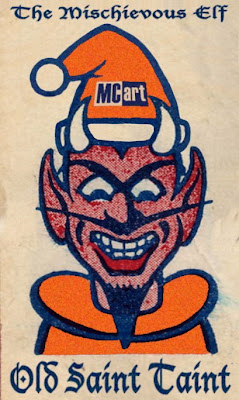










 A
A 







